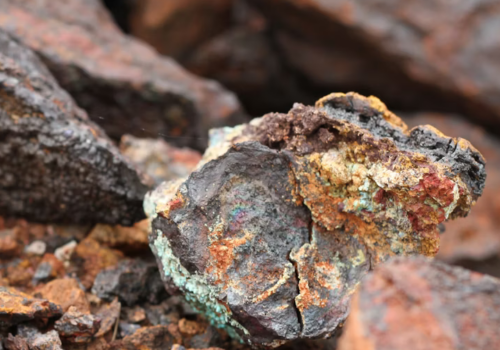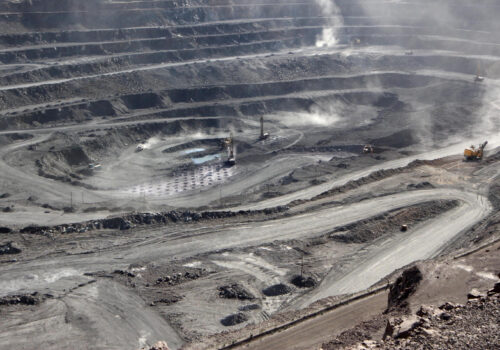Critical minerals in crisis: Stress testing US supply chains against shocks
This issue brief was updated on November 19, 2025.
Introduction
Critical minerals are foundational to the modern economy and state power via their centrality to advanced technologies across energy, military, and commercial applications. From permanent magnets in fighter jets and submarines to the batteries in electric vehicles and grid-scale storage, these inputs underpin the defense, energy, and technology bases of the United States and its partners. Yet critical mineral supply chains have become increasingly brittle: concentrated in a handful of countries, overwhelmingly refined in China, and increasingly exposed to extreme weather disruption.
China has demonstrated its willingness to weaponize its dominance over mineral markets, tightening export restrictions on graphite, antimony, and certain rare earths in retaliation for US trade and technology controls. Meanwhile, extreme droughts and heat waves are already disrupting mining and processing in regions the United States hopes to rely on for diversification. Policymakers are thus confronted with a stark question: How prepared is the United States to withstand a sudden, sustained disruption in access to critical minerals?
Policymakers in Washington are increasingly focused on mapping US critical mineral needs and boosting domestic production capacity to manage dependency risks. Given the long lead times for the development of critical mineral mining, processing, and manufacturing assets, even aggressive expansion of new, derisked supply chain activity may not yet bear fruit in time to protect the United States from a severe supply chain disruption.
To explore this challenge, the Atlantic Council, in partnership with TMP Public, convened a scenario workshop in July 2025, bringing together experts from government, industry, and academia.1This workshop was held under the Chatham House Rule. The contents of this paper and its conclusions, though built from the workshop discussion and complemented by additional research from the Atlantic Council, are not endorsed by and do not necessarily reflect the views of the workshop participants. Through two stress tests—one geopolitical, one extreme weather-driven—participants mapped the likely impacts of severe mineral disruptions, the limits of the current US response tool kit, and the role that allies, markets, and industry could play in bridging vulnerabilities.
This paper distills the insights of that exercise. It first outlines the scenarios presented, then explores the policy toolbox available to the US government and companies, before concluding with the key lessons and policy recommendations that emerged. This report’s focus is not on providing comprehensive policy recommendations to fix the structural challenges facing minerals development but rather on the US ability to respond to a major supply chain disruption.
All of this analysis is framed against a risk framework for critical mineral supply chains crafted by the Atlantic Council Scowcroft Center and Global Energy Center in June 2025. The findings highlight a concerning challenge: While the United States government and industry have some tools to manage a mineral crisis in the short term, their abilities to sustain resilience in the face of protracted disruption remain dangerously underdeveloped.
Workshop: A two-stage scenario exploring supply chain disruptions
Given widespread industry and policymaker concerns about China’s market dominance across a wide variety of critical mineral markets, the workshop covered a two-stage scenario. The first stage, Scenario A1, centers geopolitics when a de facto ban on Chinese export licenses sets off severe supply constraints. The second stage, Scenario A2, adds an extreme weather-driven crisis that compounds the challenge arising in Scenario A1. This two-stage workshop model was designed to map the public- and private-sector tool kits that could be employed as supply becomes increasingly constrained. In both stages, participants underscored that the United States would need to rapidly activate emergency tools (e.g., Defense Production Act, stockpiles, allied sourcing) while confronting the reality that scaling alternative production or processing capacity would take years.
Table 1: Scenarios A1 and A2 overview
Scenario A1: China imposes an effective ban on certain mineral exports
Context: US-China tensions escalate amid trade wars and technology rivalry.
Challenge: China implements an effective export ban on three strategically vital minerals: neodymium (Nd), dysprosium (Dy), and refined manganese (Mn). In this scenario, China chooses these three minerals because of the severe impacts of their shortages across energy, defense, and other spaces on the United States and its allies and partners. China instructs firms not to issue export licenses for Nd, Dy, and Mn to US companies. Negotiations between the United States and China on this issue have stalled. China’s deep dissatisfaction with the talks suggests that the export ban is a strategic, long-term move by the Chinese rather than a short-term negotiation tactic. The licensing regime takes full effect one month from the start date of the exercise.
Rationale:
– Dual-use applications provide diplomatic cover.
– Aimed at undercutting the US defense sector, in addition to US competitiveness – in AI, semiconductors, electric vehicles (EVs), and clean energy.
– Relatively low cost to China; high strategic impact on US security, economy, and politics. A one-year disruption of Nd, Dy, and Mn (sulfate and dioxide) supply would result in a $154 million, $1.6 billion, and $96 million reduction in US gross domestic product, respectively.
Immediate consequences:
– US public and private stockpiles will be depleted within weeks to months.
– Defense and civilian industries face hard trade-offs over allocation.
– Prices spike globally as markets scramble for alternative suppliers.

Scenario A2: Extreme weather-induced supply shock across source countries
Context: As the United States turns increasingly to other partners to mitigate the effects of Scenario A1’s export restrictions, the world faces severe drought and extreme heat over several years in a number of critical mineral-producing regions, including China, Southeast Asia, Australia, and southern Africa. These weather-driven impacts are compound shocks that worsen the Chinese export restrictions that remain in effect in Scenario A1, impacting Chinese processing facilities, as well as mining operations in Australia, South Africa, and Burma.
Challenge: Extreme weather reduces mining output, limits hydropower for processing, increases equipment failure and operational downtime, and intensifies competition for water with local communities. Supply chain interruptions ripple across production timelines for rare earths and Mn.
Rationale:
– Extreme weather-induced hazards exacerbate the strategic vulnerabilities already highlighted in Scenario A1.
– Extreme weather is increasingly frequent and unpredictable, creating a chronic risk to mineral supply chains.
– Even without Chinese export restrictions, these natural events could critically constrain global supply.
Immediate consequences:
– Production delays in affected areas reduce potential alternative supply and increase prices, leaving the United States and allies with limited options.
– Options for diplomatic work-arounds narrow as each country protects their domestic supply.
Table 2: Impact timelines
While the impact timelines in Table 2 show how disruption unfolds, the toolbox in Table 3 reveals what tools the United States can use to respond. These assessments reflect the authors’ analysis of how each tool would function in practice across both short-term crisis management and longer-term resilience building. Here, “short-term impact” refers to how effectively a tool can buffer immediate disruption and ease pressures within months, while “long-term impact” captures a tool’s ability to reshape market structures or expand supply over years.
Table 3: US response tool kit
Discussion: Scenario A1: US response to Chinese mineral export curtailment
Rapid curtailments of Chinese exports of Nd, Dy, and Mn would have immediate and cascading consequences across United States supply chains.
Both US manufacturers and government agencies have limited stockpiles to buffer disruption. The main US mineral stockpile, the National Defense Stockpile, is intentionally small as it is designed to meet critical defense needs in crisis situations, not sustain broader industry during shortages. Public data on mineral stockpiles have been limited since 2022, but data on potential acquisitions show that supplies of Nd, Dy, and, even more importantly, their derivative products that are closer to end use (like neodymium-praseodymium [NdPr] oxide and neodymium magnets, most commonly NdFeB magnets) likely have vanishingly small reserves. Many manufacturers keep small working inventories, but these generally last only a few months before shutdowns begin. In their current form, rare earths stockpiles can keep defense and manufacturing afloat for a brief disruption but offer little resilience overall.
For Mn, the National Defense Stockpile had 291,000 metric tons (t) and 114,000 t of metallurgical-grade Mn ore and high-carbon ferromanganese, respectively, as of 2021, numbers that have likely held steady. Both are helpful for keeping steel production for perhaps a year; neither has any impact on the industries affected by the Chinese ban on Mn sulfate and dioxide, such as the battery industry.
Within weeks, firms would be forced to draw down private inventories for all targeted minerals. Smaller tier 2 and tier 3 suppliers, especially those in the defense supply chains, would feel the pinch first, with production delays compounding up to OEMs and defense prime contractors within three months. At the same time, speculative buying and transshipment through third countries would drive market volatility and rapid price escalation, making it even harder for firms to secure stable supply.
During the workshop discussion regarding Scenario A1, the policy interventions to limit the damage of the first three months after China’s ban vary in reach and effectiveness. The Defense Production Act (DPA) Title I, which authorizes the government to require US companies to prioritize contracts and allocate materials for national defense, can be used as an immediate bridge to reallocate existing supplies toward defense and other security priorities, but it cannot expand supply in the near term. Ultimately, the DPA is useful for emergency coordination, but obviously cannot conjure a resource that is not there.
DPA Title III, which provides financial incentives to expand domestic industrial capacity, could accelerate investment in alternative mining or refining, but actual production would take months or years to materialize. Moreover, its impact differs across the three minerals in our scenario. Domestic Mn and Nd production could grow, but Dy is challenging to source outside of China; the DPA also can do nothing to address which minerals are or are not in the ground in the United States. As a result, while the DPA can ensure the embargo’s effects are delayed for critical national security needs, its effectiveness as a short-term tool is constrained by what materials are currently stockpiled and available on the market.
The Export Administration Regulations (EAR) provide tools to ensure there is no leakage of minerals already in the United States, but with only sparse US production, impacts are limited. For example, the United States could invoke short-supply controls (EAR Part 754) to restrict exports of Mn, Nd, and Dy already in the US market, preserving availability for domestic industry. Export controls on key US exports, like semiconductors, could also serve as leverage in negotiations with China, signaling reciprocal action or broader retaliation.
Beyond regulatory measures, financial tools are critical across the near-, medium-, and long-term under Scenario A1. Loans, guarantees, and tax credits could derisk new refining and magnet production projects outside China, while underwriting short-term diversification of Mn processing. Other key interventions with longer time horizons include permitting reform, which could accelerate approval for domestic refining, processing, and recycling projects, though the benefits would be realized only after several years.
In parallel, diplomacy would be an indispensable tool under Scenario A1. Stockpiles could temporarily cushion defense-critical uses, but consumer industries would remain highly exposed. Coordination with allies—such as Japan and South Korea, which have notably robust stockpiles—could help mitigate impacts. This is based on two assumptions: first, that allies would be willing to expose themselves to Chinese retaliation; and second, that allies would not be protective of their stock even as prices surge. Trust and coordination do not tend to surge during commodity crises.
Even if allies are still willing to proceed, the United States would have to prove itself to be the best buyer in a globally constrained market. To prepare, the US could organize prenegotiated crisis-coordination agreements to harmonize stockpile releases and reallocate scarce supplies. This would not counter a global shortage since countries would prioritize their own supply security, but it could help undermine targeted adversarial actions or localized shortages, such as the one outlined in our scenario.
The US could also turn to emergency procurement and contracting, pursuing direct arrangements, for example, with suppliers in Australia and Vietnam for rare earths or Japan and Belgium for Mn. However, volumes outside China are extremely limited, and the risk of fragmented, inflationary bidding wars is high. To counter this, the government could encourage OEMs and defense prime contractors to form purchasing consortia, consolidating buying power and reducing competition among US firms.
Even with these stopgaps, in the first year the United States would likely only recover a fraction of lost supply. Optimistically, alternative sources might replace only about 10 percent of US demand—even less for Dy—that was previously fulfilled by China for each embargoed mineral. The disruption would thus remain severe, shaping both production capacity and market dynamics for years to come.
Key lessons under Scenario A1
The United States has a severely limited tool kit to manage the immediate consequences of a Chinese embargo on Nd, Dy, and Mn. The discussion of this scenario reinforced some of these limitations, while highlighting several key lessons.
- The US government needs a clearer cross-agency map for crisis management
Contrary to other national emergencies, significant institutional gaps challenge the speed and effectiveness of the US response in this scenario. This includes a dangerously limited awareness of the United States’ own true exposure, particularly in the private sector where mineral and precursor inventories are largely unknown, clouding any assessment of where vulnerabilities lie or how significant they may be.
This is further complicated by the lack of an interagency response playbook. Though interagency participation in addressing US dependency on these minerals has increased in recent years, these efforts remain highly siloed, limiting the United States’ ability to mitigate the immediate consequences of the embargo. One such example is the Department of Defense: Though it is currently the most capable of distributing stockpiles and leveraging the DPA, its mandate requires it to prioritize disbursements toward national security-related customers. Without clear signals or a policy change to develop more robust support for the commercial sector or alleviate price pressure, exposed sectors could face severe shortages while relying on slower, longer-term supply chain interventions like asset development. - Stockpiling is necessary but insufficient
Available US stockpiles sit almost entirely within the National Defense Stockpile (NDS), which by statute is narrowly designed to support defense needs and lacks the flexibility and scale to buffer the wider civilian economy. Even with rapid acquisitions in the thirty days remaining before a full embargo (as outlined in the scenario), the US government and private sector would only be able to build a partial inventory.
Stockpiling is also uniquely difficult in the mineral sector. Many existing stockpiles are ore heavy, meaning they cannot directly support manufacturing without parallel investments in refining and magnet-making capacity. Even a “sufficient” stockpile of raw inputs may be ineffective if midstream bottlenecks persist, limiting the buffer that stockpiles can offer. In practice, stockpiles are often more useful for derisking new mineral projects by countering price manipulation than for filling market gaps during a crisis. - Engaging allies is critical—and challenging
Given domestic limitations, US crisis response would require engagement with trusted partners on several fronts. First, purchasing existing stockpiled resources from partners and allies such as Japan and South Korea, which possess much healthier stockpiling programs than the United States, could provide some relief. Second, the use of partner groupings could help US firms navigate market volatility, either through the establishment of buying consortia or trade tools to establish US firms in a more competitive position.
This, however, is complicated on several fronts. Not only might allies not have sufficient supplies to buffer US supply, but many potential partners are also themselves highly dependent on Chinese flows in one way or another, potentially constraining their willingness to participate. Past supply crises, from the 1973 oil embargo to the scramble for COVID-19 vaccines, show that even close allies often default to self-preservation when critical resources are scarce. - Longer-term resilience requires whole-of-supply-chain investment
Tools like DPA resource allocation, export controls, or emergency procurement help cushion national security needs, but none fundamentally resolve shortages and dependency. Diversifying sources and expanding domestic processing capabilities are multiyear or even multidecade endeavors. Without sustained, coordinated investments across mining, refining, and manufacturing, the United States remains highly exposed to prolonged embargoes and similar disruptions in critical mineral supply chains.
Discussion: Scenario A2: Extreme weather disruptions in key-producer countries deepen the crisis
Scenario A2 builds directly on the conditions of Scenario A1. Chinese export restrictions remain in place, but the challenge deepens as extreme weather events—in this case, drought and heat—further disrupt neodymium, dysprosium, and manganese processing and refining. In Scenario A2, drought and heat halt operations in mineral-producing countries such as China, South Africa, and Australia, cutting off access to raw materials that underlie global energy and defense supply chains. This scenario was designed to highlight how natural disasters can trigger acute critical mineral shortfalls and drive chronic instability.

Natural disasters, including extreme drought, heat, and flooding, are most acute in the upstream segment of the value chain, where operations are tied to physical geography, water availability, and energy infrastructure. For example, extreme heat may restrict workforce availability due to safety concerns and damage power systems. Midstream and downstream industries feel the effects later, but shortages in refined inputs ripple outward to global manufacturers of batteries, magnets, and other critical technologies. Unlike Scenario A1, where lost Chinese volumes might be partially offset by alternative sources, underlying production capacity itself is constrained in this scenario, removing physical capacity from global supply chains and making substitution far more limited.
The timeline of disruption under Scenario A2 differs from the rapid cascade modeled in A1. In the immediate term, extreme weather may halt operations at specific mines or smelters, causing localized shortages but not necessarily triggering a global supply crunch. Within one to six months, if alternative sources are unavailable, these outages compound into tightness in global markets, with prices spiking and downstream consumers forced to draw down inventories. Over six months to two years, repeated or prolonged shocks reduce confidence in the reliability of specific supply regions, deterring investors locally while accelerating efforts to diversify sources.
Governments and firms retain access to the same emergency tool kit—DPA authorities, stockpiles, export controls, and financial incentives—but in this scenario those levers are even less effective. Unlike an export ban where supply still exists somewhere in the system, extreme weather-driven production losses reduce the global pie. Stockpiles, already modest and dwindling, would offer little comfort and may be completely depleted. The DPA could still reallocate minerals for defense needs, but new production contracts would still take years to bear fruit. Financial support and permitting reform likewise remain slow-burn solutions.
Two features distinguish this scenario from a geopolitical shock. First, the cumulative nature of disaster risk elevates the role of adaptation and resilience. Forward-looking firms are already beginning to price such disruption into their business models, investing in diversified water sources, backup power systems, and more flexible logistics. However, these practices remain uneven and underdeveloped, with only a select few of the larger players having the capital to consider absorbing higher upfront costs. Without a stronger policy framework to incentivize and scale climate adaptation, smaller firms and entire supply chains will remain vulnerable, unable to respond beyond cutting production.
Second, diplomacy takes on a new shape. In this scenario, the United States would have less ability to rely on allies for stockpiled minerals or backdoor access to Chinese materials. Allied producers may themselves face shortfalls related to extreme weather and are even more likely to prioritize domestic demand. Instead, engagement would focus on negotiating with producers like Australia and South Africa to prioritize US flows and investing jointly in natural disaster-resilient infrastructure around mine sites. These steps could not eliminate the shortfall, but they would help build a foundation for future resilience.
Key lessons under Scenario A2
As under Scenario A1, the United States has a limited tool kit to manage the consequences of extreme weather-driven limitations of global production of Nd, Dy, and Mn. The workshop discussion revealed several insights that both US government and allied policymakers should take more fully into account.
- Diversification must account for shocks driven by extreme weather and natural disasters, not just geopolitics. Unlike a politically motivated embargo where trade can be rerouted, extreme weather events can temporarily or permanently remove production capacity from even trusted foreign or domestic sources. Therefore, resilience cannot just focus on nearshoring or friendshoring supply chains but rather must be redundant and geographically distributed so they can absorb shocks from natural disasters as well as geopolitical action. Furthermore, uneven exposure to extreme weather means that while resource quality and cost remain paramount, sourcing decisions may increasingly prioritize regions with lower disaster risk, even if the resources are otherwise less attractive. Recycling and circularity also offer parallel sources of supply that are more insulated from disaster-driven shocks. Expanded magnet recycling, for example, could help stabilize Nd and Dy availability, providing a buffer against both short-term shocks and chronic scarcity.
- Adaptation is inseparable from mineral security. Disaster risks are not a distant concern but a material, immediate factor shaping global mineral flows. Larger companies increasingly recognize this and are investing accordingly by integrating weather-related risk into their operations and financing. For example, for Mn producers in water-scarce regions, ignoring drought or heat is not an option. While some leading firms are working to internalize these risks, many others are completely unprepared. Companies can pursue comprehensive, system-level shifts, such as market-based approaches that price in such disruption risk and help incentivize resilience and resource allocation. Smaller firms, however, often lack the capital to invest in adaptation at scale, leaving them disproportionately exposed. Zooming in to site-level adaptation, many companies already have localized measures in place, such as water management, community partnerships, and diversification of energy supply, but these are rarely sufficient as disasters increase in frequency and intensity. Meanwhile, governments have largely failed to plan, often treating a mineral strategy as divorced from disaster resilience. Without a policy framework that incentivizes and supports adaptation across the whole supply chain, national security and industrial priorities remain at the mercy of disaster-driven shocks.
- Institutional readiness for nonadversarial supply shocks is underdeveloped. The scenario underscored the absence of clear government processes for responding to disruptions caused by extreme weather events rather than hostile actions. Agencies could struggle to decide whether trade, energy, or defense authorities were in the lead, obfuscating agencies’ sense of ownership and slowing response. The United States needs a coherent interagency framework that treats climate-linked disruptions as a strategic risk category, complete with predefined authorities and operational playbooks, rather than assuming only adversarial actions will threaten supply.
- Short-term emergency tools cannot replace preemptive resilience. Emergency tools offer short-term relief but cannot substitute for supply chains resilient to multiyear disruptions such as long-term drought. This scenario underscores the importance of preemptive investment in resilience, be it diversifying the energy inputs that power mining and refining or embedding redundancy through alternative suppliers and recycling. Such shocks will not wait for permitting reform or procurement contracts; resilience must be in place before the disruption arrives.
Conclusion: Preparing for crisis
Whether triggered by deliberate policy in Beijing or extreme weather around the world, the United States and its allies are just one disruption away from insecure supply chains for the minerals most critical for defense readiness and energy build-out.
Across both scenarios, a core set of emergency policy tools recurred: the DPA, the National Defense Stockpile and private stockpiles, emergency procurement authorities, and diplomacy. These instruments can help soften the immediate blow and reallocate scarce resources to mission-critical sectors. However, the exercise revealed that their effectiveness is uneven in crisis scenarios. Some tools, such as stockpiles and DPA prioritization, can only redistribute or smooth supply; they cannot generate new production and, by design, remain poorly calibrated to the scale and duration of potential crises. Other tools, such as permitting reform and financial incentives, are inherently long-term plays, essential for resilience, but irrelevant to short-term crisis management. Diplomacy’s ability to counter emergency shortages, meanwhile, is contingent on circumstances: Scenario A1 creates conditions where third-country suppliers can still channel volumes toward allies, but in Scenario A2, partners face similar supply constraints, limiting diplomacy’s utility as a stopgap. In the longer term, coordination on diversification remains a particularly powerful tool, though robust multilateralism has been slow to manifest in practice.
Diversification emerged as the single most important theme, but the scenarios showed that not all diversification strategies are created equal. In a geopolitical shock like Scenario A1, diversification is about reducing reliance on China by cultivating alternative partners and trade routes. In an extreme weather shock like Scenario A2, diversification must be about physical redundancy: ensuring supply chains are geographically distributed enough that a drought, flood, or cyclone cannot take out a large share of global capacity in one stroke. Recycling and circularity take on greater weight here, offering supply streams that are less vulnerable to both political and physical disruption.
When both scenarios are layered on top of each other, it becomes clear that US and allied supply chains would be hard-pressed to absorb just one of the above shocks, let alone both compounded. Existing mitigation and diversification strategies fall far short of what would be needed to maintain supply under these conditions. A key question for policymakers is whether current strategies are robust across both pathways or whether they remain overly skewed to geopolitical contingencies at the expense of disaster resilience.
The lesson of the scenarios is clear: Mineral security must be approached as a continuum of risks, where short-term tools and long-term strategies are designed in tandem and where geopolitical and disaster-related contingencies are addressed with equal seriousness.
About the authors
Acknowledgements
The Atlantic Council would like to thank TMP for its support of this project.
This report is written and published in accordance with the Atlantic Council’s policy on intellectual independence. The authors are solely responsible for its analysis and recommendations. The Atlantic Council and its donors do not determine, nor do they necessarily endorse or advocate for, any of this report’s conclusions.
Related content
Explore the programs

The Scowcroft Center for Strategy and Security works to develop sustainable, nonpartisan strategies to address the most important security challenges facing the United States and the world.

The Global Energy Center develops and promotes pragmatic and nonpartisan policy solutions designed to advance global energy security, enhance economic opportunity, and accelerate pathways to net-zero emissions.
Image: Photo by MiningWatch Portugal on Unsplash






